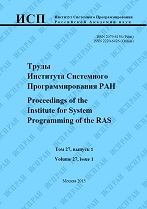|
Deep web users deanonimization system
S. M. Avdoshin, A. V. Lazarenko
National Research University Higher School of Economics
Abstract:
Privacy enhancing technologies (PETs) are ubiquitous nowadays. They are beneficial for a wide range of users: for businesses, journalists, bloggers, etc. However, PETs are not always used for legal activity. There a lot of anonymous networks and technologies which grants anonymous access to digital resources. The most popular anonymous networks nowadays is Tor. Tor is a valuable tool for hackers, drug and gun dealers. The present paper is focused on Tor users' deanonimization using out-of-the box technologies and a basic machine learning algorithm. The aim of the work is to show that it is possible to deanonimize a small fraction of users without having a lot of resources and state-of-the-art machine learning techniques. The first stage of the research was the investigation of contemporary anonymous networks. The second stage was the investigation of deanonimization techniques: traffic analysis, timing attacks, attacks with autonomous systems. For our system, we used website fingerprinting attack, because it requires the smallest number of resources needed for successful implementation of the attack. Finally, there was an experiment held with 5 persons in one room with one corrupted entry Tor relay. We achieved a quite good accuracy (70%) for classifying the webpage, which the user visits, using the set of resources provided by global cybersecurity company. The deanonimization is a very important task from the point of view of national security.
Keywords:
Tor, deanonimization, website fingerprinting, traffic analysis, anonymous network, deep web.
Citation:
S. M. Avdoshin, A. V. Lazarenko, “Deep web users deanonimization system”, Proceedings of ISP RAS, 28:3 (2016), 21–34
Linking options:
https://www.mathnet.ru/eng/tisp35 https://www.mathnet.ru/eng/tisp/v28/i3/p21
|

| Statistics & downloads: |
| Abstract page: | 240 | | Full-text PDF : | 110 | | References: | 36 |
|




 Contact us:
Contact us: Terms of Use
Terms of Use
 Registration to the website
Registration to the website Logotypes
Logotypes









 Citation in format
Citation in format 